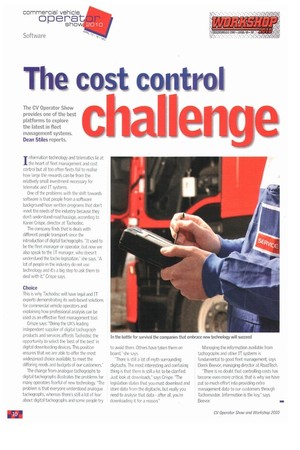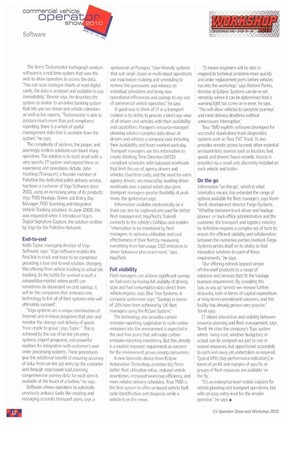The cost control
Page 68

Page 70

If you've noticed an error in this article please click here to report it so we can fix it.
The CV Operator Show provides one of the best platforms to explore the latest in fleet management systems. Dean Stiles reports.
Information technology and telematics lie at the heart of fleet management and cost control but all too often fleets fail to realise how large the rewards can be from the relatively small investment necessary for telernatic and IT systems.
One of the problems with the shift towards software is that people from a software background have written programs that don't meet the needs of the industry because they don't understand road haulage, according to Karen Crispe, director at Tachodisc.
The company finds that is deals with different people transport since the introduction of digital tachographs. "It used to be the fleet manager or operator, but now we also speak to the IT manager, who doesn't understand the taelio legislation," she says. ''A lot of people in the industry do not use technology and its a big step to ask them to deal with it,' Crispe says.
Choice
This is why Tachodisc will have legal and IT experts demonstrating its web-based solutions for commercial vehicle operators and explaining how professional analysis can be used as an effective fleet management tool.
Crispe says: "Being the UK's leading independent supplier of digital tachograph products and services affords Tachodisc the opportunity to select the 'best of the best' in digital downloading devices. This position ensures that we are able to offer the most widespread choice available, to meet the differing needs and budgets of our customers,' The change from analogue tachographs to digital tachographs illustrates the problems for many operators fearful of new technology. "The problem is that everyone understood analogue tachographs, whereas there's still a lot of fear about digital tachographs and some people try to avoid them. Others have taken them on board," she says.
"There is still a lot of myth surrounding dig itachs. The most interesting and confusing thing is that there is still a lot to be clarified. Just look at downloads," says Crispe. "The legislation states that you must download and store data from the dig itachs, but really you need to analyse that data after all, you're downloading it for a reason." Managing the information available from tachographs and other IT systems is fundamental to good fleet management, says Derek Beevor, managing director at RoadTech.
''There is no doubt that controlling costs has become even more critical, that is why we have put so much effort into providing extra management data to our customers through Tachomaster. Information is the key,'' says Beevor.
The firm's Tachomaster tachograph analysis software is a real time system that uses the web to allow operators to access the data. "You can scan analogue charts or read digital cards, the data is analysed and available to you immediately," Beevor says. He describes the system as similar to an online banking system that lets you see driver and vehicle calendars as well as live reports. 'Tachomaster is able to produce much more than just compliance reporting, there is a whole of useful management data that is available from the system' he says.
The complexity of systems, the jargon, and seemingly endless solutions can daunt many operators. The solution is to start small with a very specific IT system and expand these as experience and operations dictate. John Hackling (Transport), a founder member of Palletline the dedicated pallet delivery service, has been a customer of Vigo Software since 2001, using an increasing array of its products: Vigo TMS Haulage, Online Job Entry, Bay Manager, POD Scanning and integrated Vehicle Tracking solutions. In June 2008, this was expanded when it introduced Vigo's Digital Signature Capture, the solution written by Vigo for the Palletline Network End-to-end
Keith Taylor, managing director of Vigo Software, says: "Vigo software enables the final link in track and trace to be completed providing a true end-to end-solution, changing this offering from vehicle tracking to actual job tracking. In the battle for survival in such a competitive market where profit can sometimes be dependent on cost savings, it will be the companies that embrace new technology to link all of their systems who will ultimately succeed".
"Vigo systems are a unique combination of Internet and in-house programs that plan and monitor the storage and delivery of goods 'from cradle to grave', says Taylor. "This is achieved by the use of on-line job entry systems, import programs, and powerful routines for integration with customer's own order processing systems. These procedures give the additional benefit of ensuring accuracy of data From on-line job entry by the customer and through map-based load planning, comprehensive journey data for each item is available at the touch of a button," he says.
Software allows operators to automate previously arduous tasks like creating and managing accurate transport plans, says a spokesman at Paragon. "User-friendly systems that suit single depot or multi-depot operations use map-based routeing and scheduling to remove the guesswork and reliance on individual schedulers and bring new operational efficiencies and savings to any size of commercial vehicle operation," he says.
A good way to think of IT in a transport context is its ability to provide a bird's eye view of all drivers and vehicles with their availability arid capabilities. Paragon's resource-managed planning solution compiles data about all drivers and vehicles a company uses including their availability and hours worked each day. Transport managers use this information to create Working Time Directive (WTD) compliant schedules with balanced workloads that limit the use of agency drivers and vehicles. Overtime costs, and the need for extra agency drivers, are reduced by levelling driver workloads over a period which also gives transport managers greater flexibility at peak times, the spokesman says.
Information available electronically on a truck can also be captured and used for better fleet management. HaulTech's Trakm8 connects to the vehicle's CAN bus and enables "information to be monitored by fleet managers, to optimise utilisation and cost effectiveness of their fleet by measuring everything from fuel usage, CO2 emissions to driver behaviour plus much more." says HaulTech.
Full visibility
Fleet managers can achieve significant savings on fuel costs by having full visibility of driving style and fuel consumption data direct from vehicle engines, says Blue Tree Systems. A company spokesman says: "Savings in excess of 15% have been achieved by Ulf fleet managers using the R:Com System."
The technology also provides carbon emission reporting. Legislation to curb carbon emissions into the environment is expected in the next few years that will make carbon emission reporting mandatory. But this already is a market-imposed requirement as concern for the environment grows among consumers.
A new telematic device from Eclipse Automotive Technology promises big fleets better fleet utilisation ratios, reduced vehicle downtimes, increased workshop efficiency, and more reliable delivery schedules. Texa TMD is the first system to offer on-board vehicle fault code identification and diagnosis while a vehicle is on the move. "It means engineers will be able to respond to technical problems more quickly and order replacement parts before vehicles run into the workshop," says Richard Parkin, director at Eclipse. Systems can be re-set remotely where it can be determined that a warning light has come on in error, he says. "This will allow vehicles to complete journeys and meet delivery deadlines without unnecessary interruption."
Texa TMD exploits software developed for successful stand-alone truck diagnostics systems such as Texa TXT Truck. It also provides remote access to most other essential on-board data sources such as location, fuel, speed, and drivers' hours records. Access is provided via a small unit, discretely installed on each vehicle and trailer.
On the go
Information "on-the-go", which is what telematics means, has extended the range of options available for fleet managers, says Kevin Terrill, development director Fargo Systems. "Whether between truck driver and haulage planner, or back-office administration and the customer, the transport and logistics industry by definition requires a complex set of tools to ensure the efficient visibility and collaboration between the numerous parties involved. Fargo Systems prides itself on its ability to find innovative solutions to each of these requirements," he says.
"Our offering extends beyond simple off-the-shelf products to a range of solutions and services that fit the haulage business requirement. By providing the 'Pay as you go' service we remove further obstacles, both in terms of capital expenditure or long-term commitment concerns, and this facility has already proven very popular," Terrill says.
IT allows interaction and visibility between resource planning and fleet management, says Terrill. He cites the company's Tops system where "every cost, whether budgetary or actual, can be assigned not just to one or several resources, but apportioned accurately to each and every job undertaken as required. Typical KPIs [key performance indicators] in terms of profit and margins of specific or groups of fleet resources are available 'on the fly'.
"It's an enterprise-level mobile solution for vehicle planning arid transport operations, but with an easy entry-level for the smaller operator," he says. •






























































































































































































